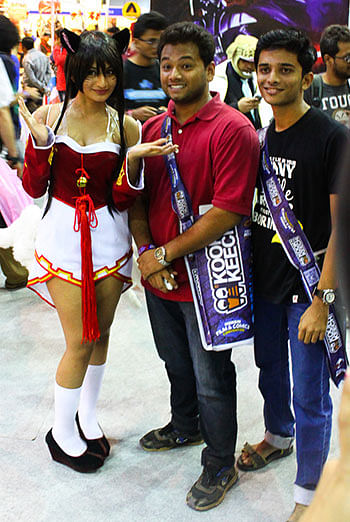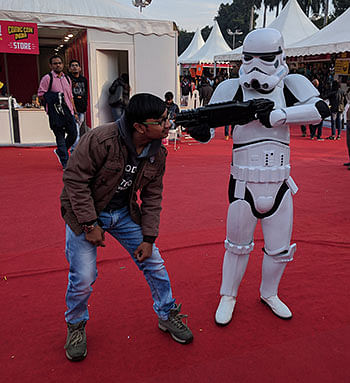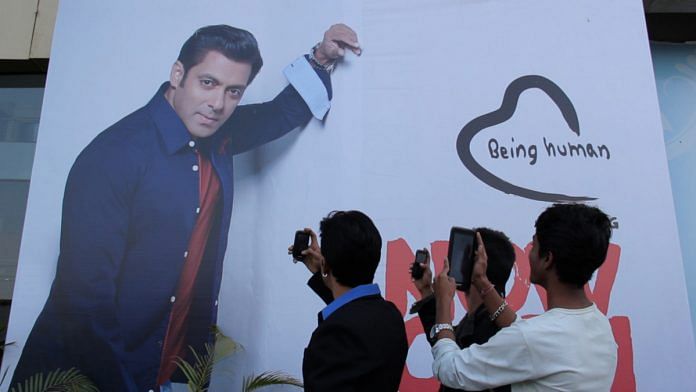New Delhi: “In brightest day, in blackest night,
No fandom shall escape our sight.
Let those who worship fandom’s might
Be welcome in FUI’s light!”
This is the virtual clarion call for all “geeks, nerds, intellectuals” — essentially hardcore fans of absolutely anything — to join Fandoms United India, one of the largest Indian fandom groups on Facebook.
What is fandom, you ask? It could range from just a group of people who have a common interest and share basic references to an active community of dedicated fans who engage in regular discussion and debate as part of a forum and may create “fanworks” — artwork, video or fiction — centred around the thing that they love.
We’ve all seen fandoms. A crowd of hysterical cricket lovers, a bunch of millennials, who call themselves One-Directioners, Beliebers, Swifties, members of the Beyhive — Reddit threads are full of memes one cannot comprehend, the hordes who assemble diligently in front of Amitabh Bachchan’s house every Sunday, Instagram images of people dressed like comic book characters, an arena full of K-Pop fans. From mainstream to niche to obscure, there are fan communities that surround us every day.
Fandoms may be local or transnational in nature, but can often be such a specific subculture that they are like worlds unto themselves. But yearly conventions like Comic Con India (CCI), and this weekend’s Mumbai-based event The Great Indian Fandom organised by Godrej India Culture Lab, are an indication that fandoms are ready to come out in the mainstream and be taken more seriously.

Fans mean business
The difference in being a member of an audience or fandom depends on the degree of attachment and investment one has, explains Dr Rukmini Pande, professor at Jindal Global University and editor of the Journal of Fandom Studies.
In this respect, fans are not just mute spectators but active stakeholders. Pottermore, for instance, is a fan favourite digital platform where one can take quizzes, upload their own fan fiction and read alternative endings or theories — all based on the Harry Potter books and movies.
For student Aanchal Manuja, the most exciting part is reading all the extra material shared by author J.K. Rowling herself. “There’s an entire article about an American magic school, Livermony. But my favourites are the background stories she provides of characters that helps me understand the nuances of their personality better,” she says.
Such communities come with their own language codes, sharing love and references about a particular thing are only the basics.
“Fandom has so many internalised special definitions and linguistics, it can often seem impenetrable, especially to a newcomer or outsider,” wrote Vox reporter Ajo Romano. Terms like shipping, fanon or OTP may seem nonsensical to those who aren’t clued in on internet fanspeak, but have very specific meanings that enable fans to take ownership of their favourite characters.
The levels of investment and creativity some fans bring to the table is undeniable. The Fifty Shades of Grey book series, which later turned into a successful movie franchise, emerged from Twilight fan-fiction after all.
Also read: K-pop fans a growing tribe in India — they hold concerts, do charity, run stores
From geeky and shy to loud and proud
Fans and fan communities have existed in some form for a long time, but what has changed is the wide acceptance of those who wear their “fannish” hearts on their sleeves.
Pande explains why many in the past have often been reluctant to reveal that they are fans. “There’s been a history of negative association with fannishness. Fans are often seen as irrational, unthinking and unreasonable. That definitely plays into ideas of whether people want to call themselves fans.”
Saniya Shaikh, the curator of the Great Indian Fandom Conference, echoes this sentiment as she recalls being an ardent fan of many things from a young age, but found solace in internet fora, many of which centred around queer fandoms. “Fan culture has always been considered mysterious and hard to understand,” she rues.
People were not just shy to display their fan identities, but the lack of open dialogue also meant that fan communities were that much harder to form, often being relegated to solely virtual spaces. “When I met my fan friends, there was the dance around the fact whether we were fans, whether we knew about fan fiction. It wasn’t seen as something legitimate or wasn’t quite something that spoke about openly. But now that’s changed considerably,” notes Pande.

After completing her Masters, Pande realised that she couldn’t get herself to write “the millionth thesis on Shakespeare”. She knocked on many doors with an unconventional MPhil proposal centred around fandom, and eventually found an enthusiastic response from Jawaharlal Nehru University. After completing her MPhil from JNU, she went on to do her PhD in online fan cultures at the University of Western Australia.
As one of the India’s first fan studies scholars, she has observed a significant rise in the number of people who are now turning their research interests towards the field. “There’s a generational shift how fandoms work, and how people are looking at fandom as something that’s significant to the way we understand culture, communication, attachment and community building,” she notes.
Even for Jatin Verma, the founder of India’s biggest fandom convention, Comic Con, the act of openly building a community around his interests was a long process. After harbouring a deep love for comics since his childhood, along with repeated failed attempts at contributing to Tinkle magazine, Verma finally found his calling in the comic book publishing industry. But in 2011, he decided to take a leap of faith and launched Comic Con India.
“The whole idea of doing a Comic Con was a passion project. I’d get to be the first person to do something like this in India, even if it failed,” he tells ThePrint.
It started as a two-day event in New Delhi in February 2011, with 25 exhibitors and 5,000 visitors. Eight years later, CCI has spread to Mumbai, Bengaluru, Hyderabad, Pune and Ahmedabad, and attracted over 2 lakh cumulative visitors and featured over 1,200 exhibitors.
Apart from its city-based main events, Comic Con regularly hosts Pop Ups, Culture Forums, and the Indian Championship of Cosplay — where participants wear elaborate costumes fashioned after their favorite characters and compete for a chance to represent India internationally.
Verma tells ThePrint how the whole idea of showing and celebrating one’s individual passions felt akin to “coming out of the closet”. “A few years in to Comic Con, I truly felt that maybe we were growing faster than the market, but now it doesn’t feel like that. The whole idea of showing your fandom for something is now out in the open and we are in the middle of it!”
Comic Con India chanced upon a great business opportunity by opening up itself to the sale of merchandise, books and products by different artists. But familiarising Indian audiences with Western practices like Cosplay was a slower process. For the first show, he and his entire team, along with their army of volunteers, cosplayed themselves in order to get people excited. Now, many new cosplayers are professionals.
Also read: Salman Khan’s Eid release Bharat finally has him play a character his age — a 70-year-old
Western versus Indian fandoms
Most mainstream fandom networks today are centred around Western pop culture and white-centric characters. Noting this dissonance, Shaikh sought out to explore what Indian fandom was by bringing together academics, writers, filmmakers and fans all under one roof for the Great Indian Fandom Conference.
Film studies scholar Dr S.V. Srinivas’s session explored celebrity worship in south Indian fan clubs, via the lens of certain Rajinikanth fan clubs formed by upper-caste men who seek his approval.
The ‘Fanscaping Communities of India’ panel included speakers Amlan Das, media manager at FC Dynamos, who discussed the intersection of football fandom and patriotic nationalism, and Rajendra B. Aklekar of the Indian Railways Fan Club, who spoke about fandom being instrumental to building pride around heritage.
Dr Pande launched her book Squee from the Margins: Fandom and Race, which explores issues of race and identity in fan spaces. Sharing her experience of interviewing fans from nine countries, she spoke of how fans engaged with race and racism in various virtual spaces that centred around English-centric fandoms that looked at American texts.
Recounting the strong critique south Asian fans offered when one Avengers movie featured Hulk waking up in problematically portrayed Kolkata, she admits that there is now a growing awareness about diversity and representation. “But we (still) have to think about India’s problems with its own anti-blackness, and other virulent forms of racism,” she added.
The questions posed by the conference are not necessarily confined to what Indian fandoms tell us about the objects of their fandom, but what they tell us about India itself.
Filmmakers Samreen Farooqi and Shabani Hassanwalia, who screened their documentary Being Bhaijaan (2014), didn’t set out with the intention to make a film about Salman Khan fans. But in the process of trying to understand a type of masculinity in India, they grew interested in gender codes present in Khan’s films like Wanted (2009) and how legions of fans were absorbing these codes.
The documentary explores the lives of two superfans — Shan and Balram, based in Chhindwara. “They were like devotees. Salman Khan is like God for them,” Farooqui tells ThePrint.
Apart from following how the characters emulated Khan’s style and person, the film explored what it was about Khan that made him tick in small town India.
“They’ve taken to Salman because they are in a particular place in their life in the history of this country. They are the ones globalisation has done nothing for. The promise of globalisation had reached, the promise of jobs had reached. But Salman Khan says to them, you don’t need money, you don’t need women, you are a hero in yourself and you can do it. You are a person of the soil, and you are larger than life. And that is something that really speaks to them, being who they are and where they are in life.”
Also read: Korean pop in India — a love affair that could well define this generation







I am sorry but there is a mistake in the spelling…..The American School of Magic is not Livermony but it is Ilvermorny…..Plz correct
Thank you.